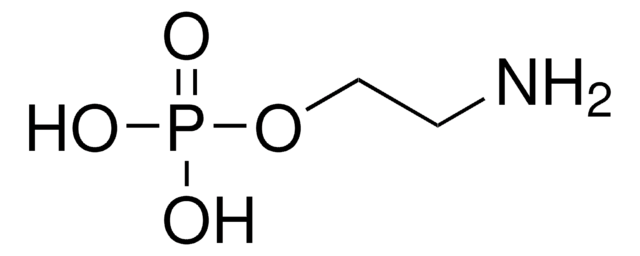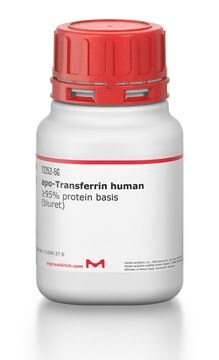E0135
Ethanolamine
liquid, BioReagent, suitable for cell culture, ≥98%
Sinónimos:
2-Aminoethanol, 2-Aminoethyl alcohol, ETA, MEA, MEA 90, MEA-LCI, Monoethanolamine
About This Item
Productos recomendados
densidad de vapor
2.1 (vs air)
Nivel de calidad
presión de vapor
0.2 mmHg ( 20 °C)
Línea del producto
BioReagent
Análisis
≥98%
formulario
liquid
temp. de autoignición
1436 °F
lim. expl.
17 %
concentración
16.6 M
técnicas
cell culture | mammalian: suitable
índice de refracción
n20/D 1.454 (lit.)
pKa (25 °C)
9.5(lit.)
bp
170 °C (lit.)
69-70 °C/10 mmHg
mp
10-11 °C (lit.)
densidad
1.012 g/mL at 25 °C (lit.)
cadena SMILES
NCCO
InChI
1S/C2H7NO/c3-1-2-4/h4H,1-3H2
Clave InChI
HZAXFHJVJLSVMW-UHFFFAOYSA-N
¿Está buscando productos similares? Visita Guía de comparación de productos
Categorías relacionadas
Aplicación
Palabra de señalización
Danger
Frases de peligro
Clasificaciones de peligro
Acute Tox. 4 Dermal - Acute Tox. 4 Inhalation - Acute Tox. 4 Oral - Aquatic Chronic 3 - Eye Dam. 1 - Skin Corr. 1B - STOT SE 3
Órganos de actuación
Respiratory system
Código de clase de almacenamiento
8A - Combustible corrosive hazardous materials
Clase de riesgo para el agua (WGK)
WGK 2
Punto de inflamabilidad (°F)
195.8 °F - Pensky-Martens closed cup
Punto de inflamabilidad (°C)
91 °C - Pensky-Martens closed cup
Equipo de protección personal
Faceshields, Gloves, Goggles, type ABEK (EN14387) respirator filter
Elija entre una de las versiones más recientes:
¿Ya tiene este producto?
Encuentre la documentación para los productos que ha comprado recientemente en la Biblioteca de documentos.
Los clientes también vieron
Nuestro equipo de científicos tiene experiencia en todas las áreas de investigación: Ciencias de la vida, Ciencia de los materiales, Síntesis química, Cromatografía, Analítica y muchas otras.
Póngase en contacto con el Servicio técnico












